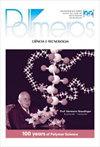Superabsorbent biodegradable CMC membranes loaded with propolis: Peppas-Sahlin kinetics release
IF 1.4
4区 化学
Q4 POLYMER SCIENCE
引用次数: 0
Abstract
Propolis is a resinous product collected by honeybees with a complex chemical composition. Sodium carboxymethylcellulose is a polymer commonly used in wound care. The goal of the present work was to produce and characterize NaCMC membranes loaded with extract of Brazilian brown propolis (CMC-P). Flavonoids and phenolic acids were identified in the propolis extracts, where the main identified substance was kaempferide. The brown propolis extracted was active against S. aureus . The low swelling capacity and high gel fraction of CMC-P would be the consequence of propolis (responsible for a hydrophobic barrier) filling the pores of the membrane. Propolis could be anchoring the NaCMC chains (as observed by FTIR) due to interaction between components, which is corroborated by the CMC-P sample degrading less than the CMC sample (>400ºC). There was non-linear diffusion release kinetics for most phenolic substances of the propolis extract. The CMC-P sample presents potential as a dressing material.负载蜂胶的高吸水性可生物降解CMC膜:Peppas-Sahlin动力学释放
本文章由计算机程序翻译,如有差异,请以英文原文为准。
求助全文
约1分钟内获得全文
求助全文
来源期刊

Polimeros-ciencia E Tecnologia
化学-高分子科学
CiteScore
2.00
自引率
0.00%
发文量
14
审稿时长
6 months
期刊介绍:
Polímeros is a quarterly publication of the Associação Brasileira de Polímeros - ABPol (Brazilian Polymer Association), which publishes Review Articles, Original Articles and Short Communications, disclosing advances in the knowledge of Polymer Science and Technology.
 求助内容:
求助内容: 应助结果提醒方式:
应助结果提醒方式:


